Bio-Corrosion of Magnesium Alloys for Orthopaedic Applications
Abstract
:1. Introduction
2. Results
2.1. Microstructure
2.2. Solution Analysis
2.2.1. pH Measurements
2.2.2. ICP-MS
2.3. Electrochemical Measurements
2.3.1. Open Circuit Potential
2.3.2. Polarization Scans
2.3.3. EIS
2.4. Comparison of Corrosion Rates
2.5. Surface Morphology
3. Discussion
4. Materials and Methods
4.1. Sample Preparation
4.2. Scanning Electron Microscopy (SEM)
4.3. Evaluation of Corrosion Behavior
4.3.1. Test Electrolyte
4.3.2. Corrosion Chamber Preparation
4.3.3. Electrochemical Tests
4.3.4. Solution Analysis
4.3.5. Surface Morphology
4.4. Statistical Analysis
5. Conclusions
- 2% Sr addition to Mg in a binary alloy, MS, is able to cause rapid dissolution of the material, likely through microgalvanic corrosion initiated by increased volume of the second phase Mg17Sr2.
- MCZ showed the lowest corrosion rate of the investigated materials.
- MCZS alloy displayed slightly increased corrosion in comparison to MCZ, but significantly lower corrosion in comparison to MS.
- All materials investigated showed evidence of fast corrosion in the physiological environment, likely due to microgalvanic corrosion between second phases and intermetallics formed by the high alloy loading.
Acknowledgments
Author Contributions
Conflicts of Interest
References
- Aspenberg, P. Silk, metal and bone: Why take implants out? Nat. Rev. Rheumatol. 2014, 10, 386–387. [Google Scholar] [CrossRef] [PubMed]
- Song, G.; Atrens, A. Understanding magnesium corrosion: A framework for improved alloy performance. Adv. Eng. Mater. 2003, 5, 837–858. [Google Scholar] [CrossRef]
- Song, G.; Atrens, A. Corrosion mechanisms of magnesium alloys. Adv. Eng. Mater. 1999, 1, 11–33. [Google Scholar] [CrossRef]
- Staiger, M.P.; Pietak, A.M.; Huadmai, J.; Dias, G. Magnesium and its alloys as orthopedic biomaterials: A review. Biomaterials 2006, 27, 1728–1734. [Google Scholar] [CrossRef] [PubMed]
- Rude, R.K. Magnesium homeostasis. Principles of Bone Biology; Bilezikian, J., Raisz, L., Martin, T., Eds.; Academic Press: Cambridge, MA, USA, 2008; Volume 1, pp. 487–513. [Google Scholar]
- Zreiqat, H.; Valenzuela, S.M.; Nissan, B.B.; Roest, R.; Knabe, C.; Radlanski, R.J.; Renz, H.; Evans, P.J. The effect of surface chemistry modification of titanium alloy on signalling pathways in human osteoblasts. Biomaterials 2005, 26, 7579–7586. [Google Scholar] [CrossRef] [PubMed]
- Cai, Y.L.; Zhang, J.J.; Zhang, S.; Venkatraman, S.S.; Zeng, X.T.; Du, H.J.; Mondal, D. Osteoblastic cell response on fluoridated hydroxyapatite coatings: The effect of magnesium incorporation. Biomed. Mater. 2010, 5, 1–7. [Google Scholar] [CrossRef] [PubMed]
- Zreiqat, H.; Howlett, C.R.; Zannettino, A.; Evans, P.; Schulze-Tanzil, G.; Knabe, C.; Shakibaei, M. Mechanisms of magnesium-stimulated adhesion of osteoblastic cells to commonly used orthopaedic implants. J. Biomed. Mater. Res. A 2002, 62, 175–184. [Google Scholar] [CrossRef] [PubMed]
- Okawachi, H.; Ayukawa, Y.; Atsuta, I.; Furuhashi, A.; Sakaguchi, M.; Yamane, K.; Koyano, K. Effect of titanium surface calcium and magnesium on adhesive activity of epithelial-like cells and fibroblasts. Biointerphases 2012, 7, 27. [Google Scholar] [CrossRef] [PubMed]
- Witte, F.; Ulrich, H.; Palm, C.; Willbold, E. Biodegradable magnesium scaffolds: Part II: Peri-implant bone remodeling. J. Biomed. Mater. Res. A 2007, 81A, 757–765. [Google Scholar] [CrossRef] [PubMed]
- Castellani, C.; Lindtner, R.A.; Hausbrandt, P.; Tschegg, E.; Stanzl-Tschegg, S.E.; Zanoni, G.; Beck, S.; Weinberg, A.M. Bone-implant interface strength and osseointegration: Biodegradable magnesium alloy versus standard titanium control. Acta Biomater. 2011, 7, 432–440. [Google Scholar] [CrossRef] [PubMed]
- Witte, F.; Kaese, V.; Haferkamp, H.; Switzer, E.; Meyer-Lindenberg, A.; Wirth, C.J.; Windhagen, H. In vivo corrosion of four magnesium alloys and the associated bone response. Biomaterials 2005, 26, 3557–3563. [Google Scholar] [CrossRef] [PubMed]
- Li, Y.; Liu, G.; Zhai, Z.; Liu, L.; Li, H.; Yang, K.; Tan, L.; Wan, P.; Liu, X.; Ouyang, Z.; et al. Antibacterial properties of magnesium in vitro and in an in vivo model of implant-associated methicillin-resistant staphylococcus aureus infection. Antimicrob. Agents Chemother. 2014, 58, 7586–7591. [Google Scholar] [CrossRef] [PubMed]
- Qin, H.; Zhao, Y.; An, Z.; Cheng, M.; Wang, Q.; Cheng, T.; Wang, Q.; Wang, J.; Jiang, Y.; Zhang, X.; et al. Enhanced antibacterial properties, biocompatibility, and corrosion resistance of degradable Mg-Nd-Zn-Zr alloy. Biomaterials 2015, 53, 211–220. [Google Scholar] [CrossRef] [PubMed]
- Tie, D.; Feyerabend, F.; Muller, W.D.; Schade, R.; Liefeith, K.; Kainer, K.; Willumeit, R. Antibacterial biodegradable Mg-Ag alloys. Eur. Cells Mater. 2013, 25, 284–298. [Google Scholar] [CrossRef]
- Brooks, E.K.; Ahn, R.; Tobias, M.E.; Hansen, L.A.; Luke-Marshall, N.R.; Wild, L.; Campagnari, A.A.; Ehrensberger, M.T. Magnesium alloy AZ91 exhibits antimicrobial properties in vitro but not in vivo. J. Biomed. Mater. Res. B Appl. Biomater. 2017. [Google Scholar] [CrossRef] [PubMed]
- Atrens, A.; Song, G.-L.; Liu, M.; Shi, Z.; Cao, F.; Dargusch, M.S. Review of recent developments in the field of magnesium corrosion. Adv. Eng. Mater. 2015, 17, 400–453. [Google Scholar] [CrossRef]
- Walker, J.; Shadanbaz, S.; Woodfield, T.B.; Staiger, M.P.; Dias, G.J. Magnesium biomaterials for orthopedic application: A review from a biological perspective. J. Biomed. Mater. Res. B Appl. Biomater. 2014, 102, 1316–1331. [Google Scholar] [CrossRef] [PubMed]
- Chen, X.-B.; Birbilis, N.; Abbott, T.B. Review of corrosion-resistant conversion coatings for magnesium and its alloys. Corrosion 2010, 67, 035005-1–035005-16. [Google Scholar] [CrossRef]
- Zainal Abidin, N.I.; Rolfe, B.; Owen, H.; Malisano, J.; Martin, D.; Hofstetter, J.; Uggowitzer, P.J.; Atrens, A. The in vivo and in vitro corrosion of high-purity magnesium and magnesium alloys WZ21 and AZ91. Corros. Sci. 2013, 75, 354–366. [Google Scholar] [CrossRef]
- Kirkland, N.T.; Lespagnol, J.; Birbilis, N.; Staiger, M.P. A survey of bio-corrosion rates of magnesium alloys. Corros. Sci. 2010, 52, 287–291. [Google Scholar] [CrossRef]
- Kirkland, N.T. Magnesium biomaterials: Past, present and future. Corros. Eng. Sci. Technol. 2012, 47, 322–328. [Google Scholar] [CrossRef]
- Feyerabend, F.; Fischer, J.; Holtz, J.; Witte, F.; Willumeit, R.; Drucker, H.; Vogt, C.; Hort, N. Evaluation of short-term effects of rare earth and other elements used in magnesium alloys on primary cells and cell lines. Acta Biomater. 2010, 6, 1834–1842. [Google Scholar] [CrossRef] [PubMed]
- Seo, H.J.; Cho, Y.E.; Kim, T.; Shin, H.I.; Kwun, I.S. Zinc may increase bone formation through stimulating cell proliferation, alkaline phosphatase activity and collagen synthesis in osteoblastic MC3T3-E1 cells. Nutr. Res. Pract. 2010, 4, 356–361. [Google Scholar] [CrossRef] [PubMed]
- Maeno, S.; Niki, Y.; Matsumoto, H.; Morioka, H.; Yatabe, T.; Funayama, A.; Toyama, Y.; Taguchi, T.; Tanaka, J. The effect of calcium ion concentration on osteoblast viability, proliferation and differentiation in monolayer and 3D culture. Biomaterials 2005, 26, 4847–4855. [Google Scholar] [CrossRef] [PubMed]
- Mushahary, D.; Wen, C.; Kumar, J.M.; Sravanthi, R.; Hodgson, P.; Pande, G.; Li, Y. Strontium content and collagen-I coating of magnesium-zirconia-strontium implants influence osteogenesis and bone resorption. Clin. Oral Implant. Res. 2014, 27, e15–e24. [Google Scholar] [CrossRef] [PubMed]
- Yang, F.; Yang, D.; Tu, J.; Zheng, Q.; Cai, L.; Wang, L. Strontium enhances osteogenic differentiation of mesenchymal stem cells and in vivo bone formation by activating Wnt/catenin signaling. Stem Cells 2011, 29, 981–991. [Google Scholar] [CrossRef] [PubMed]
- Brar, H.S.; Wong, J.; Manuel, M.V. Investigation of the mechanical and degradation properties of Mg-Sr and Mg-Zn-Sr alloys for use as potential biodegradable implant materials. J. Mech. Behav. Biomed. Mater. 2012, 7, 87–95. [Google Scholar] [CrossRef] [PubMed]
- Kirkland, N.T.; Staiger, M.P.; Nisbet, D.; Davies, M.; Birbilis, N. Performance-driven design of biocompatible mg alloys. JOM 2011, 63, 28–34. [Google Scholar] [CrossRef]
- Chen, X.B.; Kirkland, N.T.; Krebs, H.; Thiriat, M.A.; Virtanen, S.; Nisbet, D.; Birbilis, N. In vitrocorrosion survey of Mg-x Ca and Mg-3Zn-y Ca alloys with and without calcium phosphate conversion coatings. Corros. Eng. Sci. Technol. 2012, 47, 365–373. [Google Scholar] [CrossRef]
- Gu, X.N.; Xie, X.H.; Li, N.; Zheng, Y.F.; Qin, L. In vitro and in vivo studies on a Mg-Sr binary alloy system developed as a new kind of biodegradable metal. Acta Biomater. 2012, 8, 2360–2374. [Google Scholar] [CrossRef] [PubMed]
- Bornapour, M.; Muja, N.; Shum-Tim, D.; Cerruti, M.; Pekguleryuz, M. Biocompatibility and biodegradability of Mg-Sr alloys: The formation of sr-substituted hydroxyapatite. Acta Biomater. 2013, 9, 5319–5330. [Google Scholar] [CrossRef] [PubMed]
- King, A.D.; Birbilis, N.; Scully, J.R. Accurate electrochemical measurement of magnesium corrosion rates; a combined impedance, mass-loss and hydrogen collection study. Electrochim. Acta 2014, 121, 394–406. [Google Scholar] [CrossRef]
- Brooks, E.K.; Der, S.; Ehrensberger, M.T. Corrosion and mechanical performance of AZ91 exposed to simulated inflammatory conditions. Mater. Sci. Eng. C 2016, 60, 427–436. [Google Scholar] [CrossRef] [PubMed]
- Orazem, M.; Tribollet, B. Electrochemical Impedance Spectroscopy; John Wiley & Sons, Inc.: Hoboken, NJ, USA, 2008. [Google Scholar]
- Murray, J. Utilization of the specific pseudocapacitance for determination of the area of corroding steel surfaces. Corrosion 1988, 44, 533–538. [Google Scholar] [CrossRef]
- Scully, J.R. Polarization resistance method for determination of instantaneous corrosion rates. Corrosion 2000, 56, 199–218. [Google Scholar] [CrossRef]
- Zhang, L.-N.; Hou, Z.-T.; Ye, X.; Xu, Z.-B.; Bai, X.-L.; Shang, P. The effect of selected alloying element additions on properties of Mg-based alloy as bioimplants: A literature review. Front. Mater. Sci. 2013, 7, 227–236. [Google Scholar] [CrossRef]
- Ralston, K.D.; Williams, G.; Birbilis, N. Effect of ph on the grain size dependence of magnesium corrosion. Corrosion 2012, 68, 507–517. [Google Scholar] [CrossRef]
- Gusieva, K.; Davies, C.H.J.; Scully, J.R.; Birbilis, N. Corrosion of magnesium alloys: The role of alloying. Int. Mater. Rev. 2015, 60, 169–194. [Google Scholar] [CrossRef]
- Aung, N.N.; Zhou, W. Effect of heat treatment on corrosion and electrochemical behaviour of AZ91D magnesium alloy. J. Appl. Electrochem. 2002, 32, 1397–1401. [Google Scholar] [CrossRef]
- Bornapour, M.; Celikin, M.; Cerruti, M.; Pekguleryuz, M. Magnesium implant alloy with low levels of strontium and calcium: The third element effect and phase selection improve bio-corrosion resistance and mechanical performance. Mater. Sci. Eng. C Mater. Biol. Appl. 2014, 35, 267–282. [Google Scholar] [CrossRef] [PubMed]
- Ding, Y.; Li, Y.; Wen, C. Effects of Mg17Sr2 phase on the bio-corrosion behavior of Mg-Zr-Sr alloys. Adv. Eng. Mater. 2016, 18, 259–268. [Google Scholar] [CrossRef]
- Kirkland, N.T.; Birbilis, N.; Walker, J.; Woodfield, T.; Dias, G.J.; Staiger, M.P. In vitro dissolution of magnesium-calcium binary alloys: Clarifying the unique role of calcium additions in bioresorbable magnesium implant alloys. J. Biomed. Mater. Res. B Appl. Biomater. 2010, 95, 91–100. [Google Scholar] [CrossRef] [PubMed]
- Ehrensberger, M.T.; Gilbert, J.L. The effect of scanning electrochemical potential on the short-term impedance of commercially pure titanium in simulated biological conditions. J. Biomed. Mater. Res. A 2010, 94, 781–789. [Google Scholar] [CrossRef] [PubMed]
- Ehrensberger, M.T.; Sivan, S.; Gilbert, J.L. Titanium is not “the most biocompatible metal” under cathodic potential: The relationship between voltage and MC3T3 preosteoblast behavior on electrically polarized cpti surfaces. J. Biomed. Mater. Res. A 2010, 93, 1500–1509. [Google Scholar] [PubMed]
- Brooks, E.K.; Tobias, M.E.; Yang, S.; Bone, L.B.; Ehrensberger, M.T. Influence of MC3T3-E1 preosteoblast culture on the corrosion of a T6-treated AZ91 alloy. J. Biomed. Mater. Res. B Appl. Biomater. 2015, 104, 253–262. [Google Scholar] [CrossRef] [PubMed]
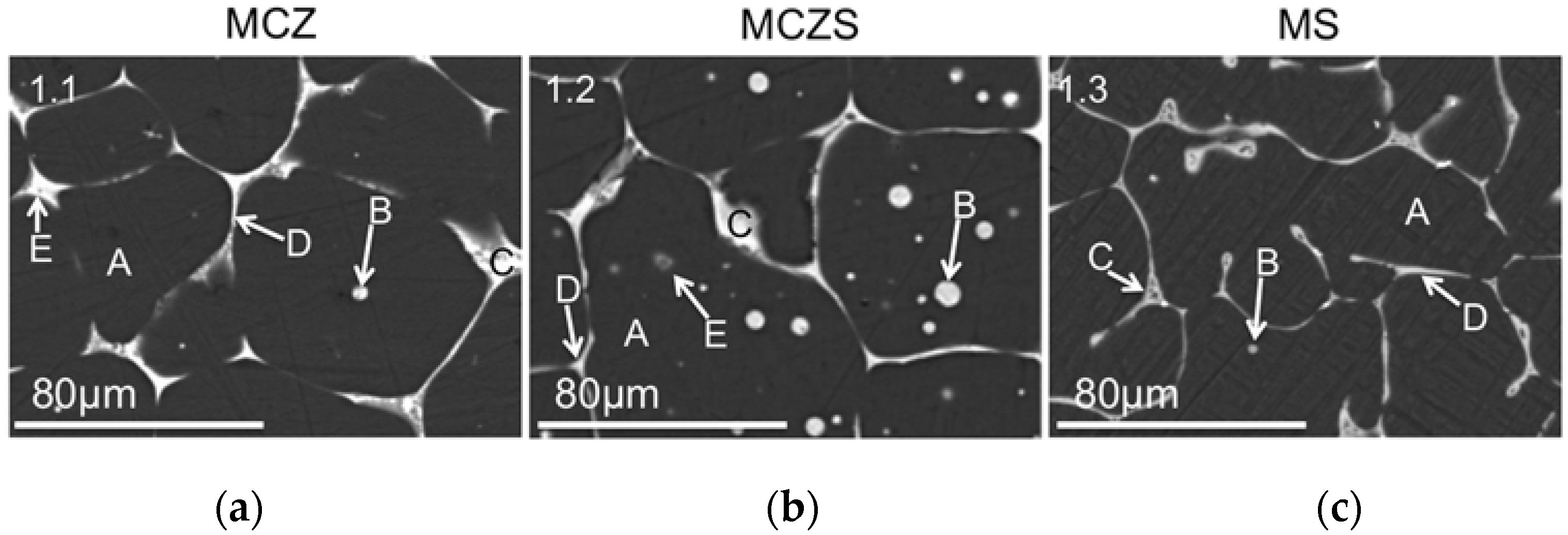
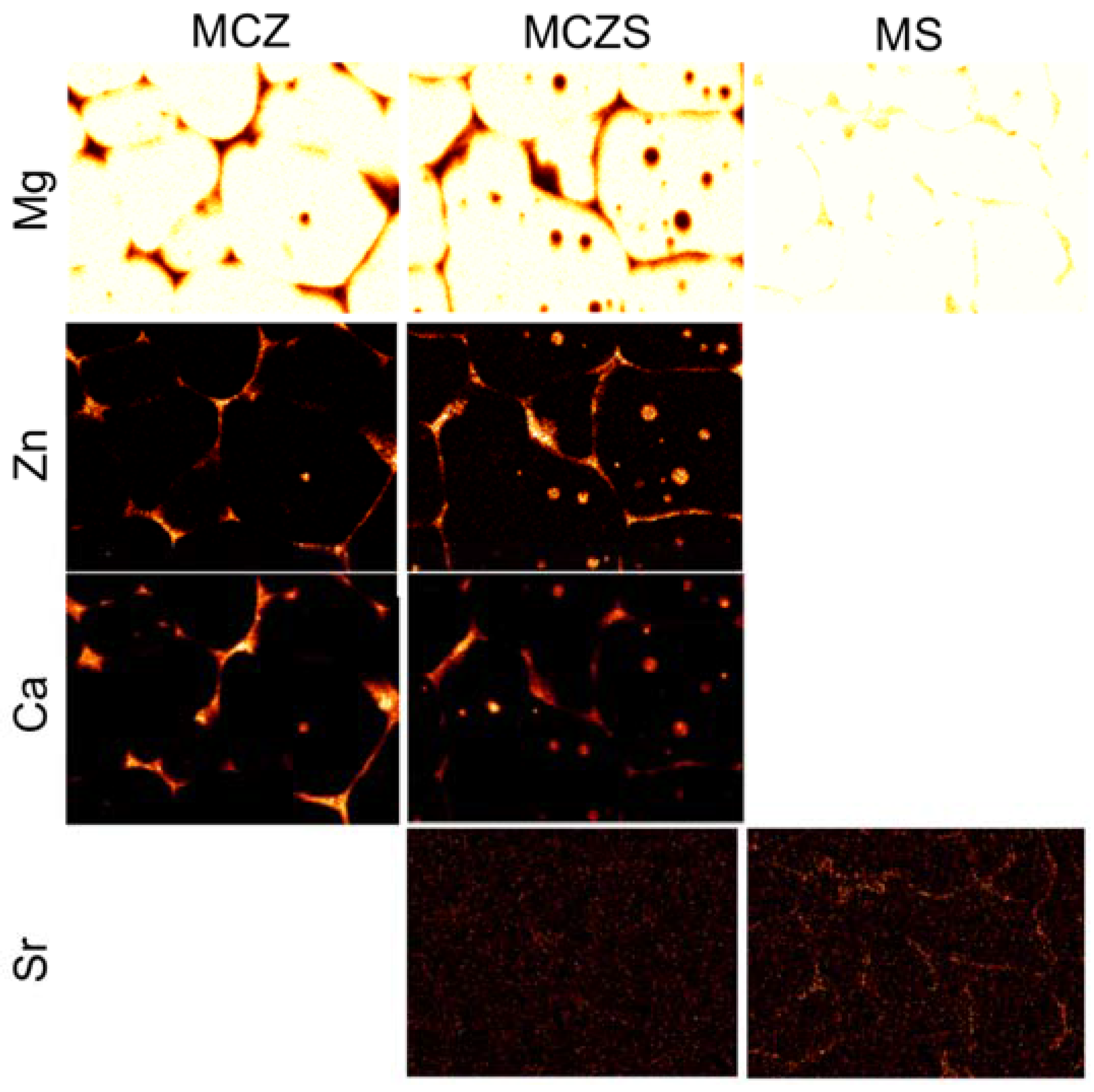

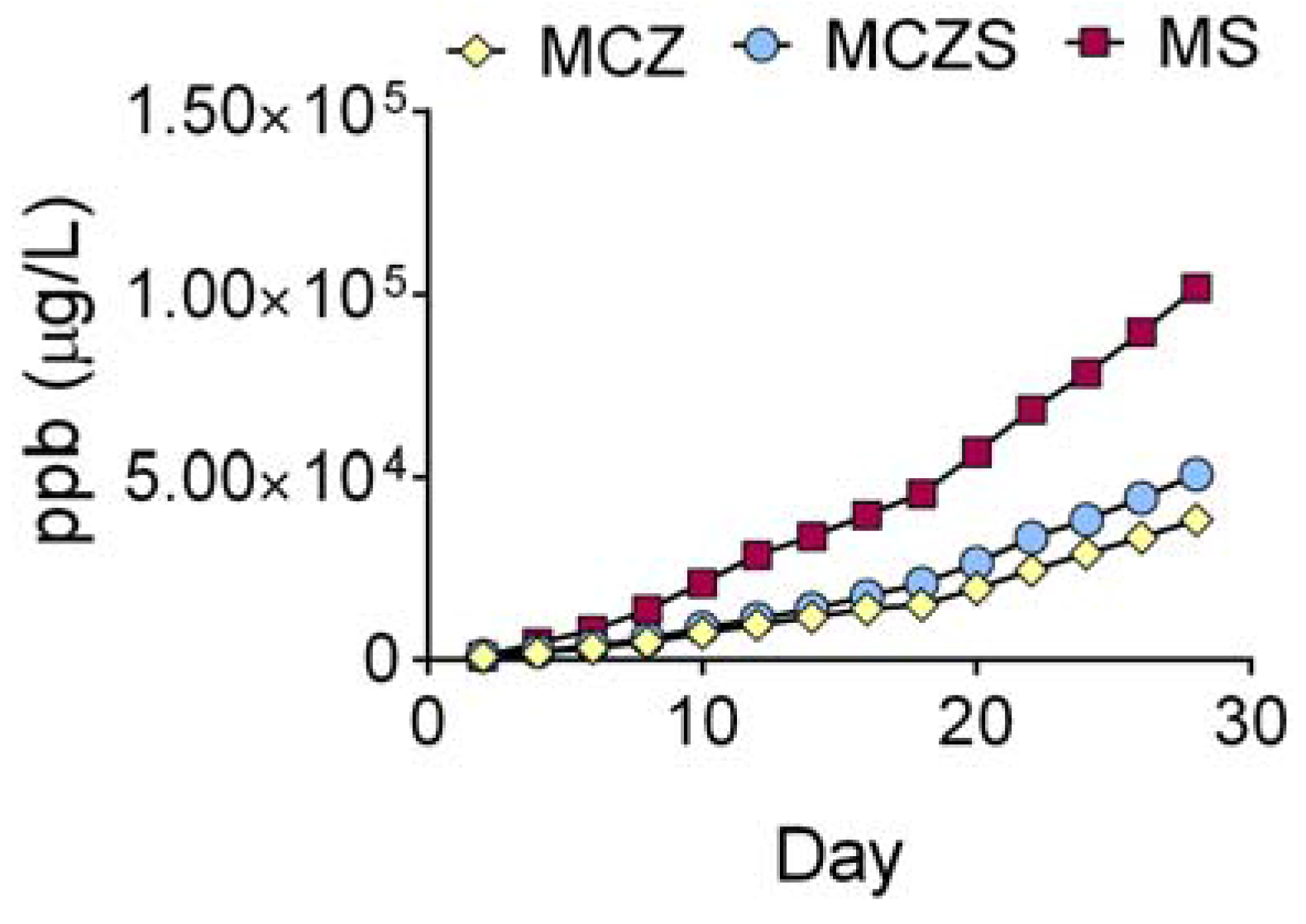



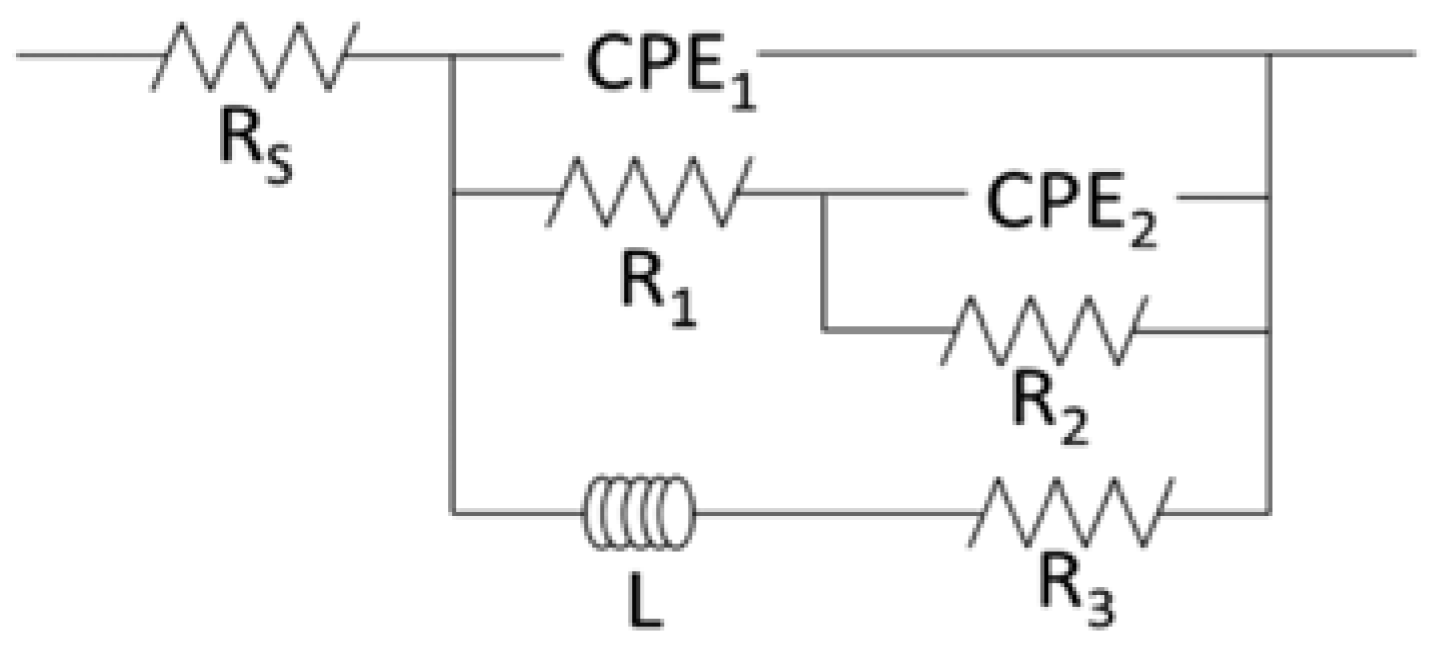
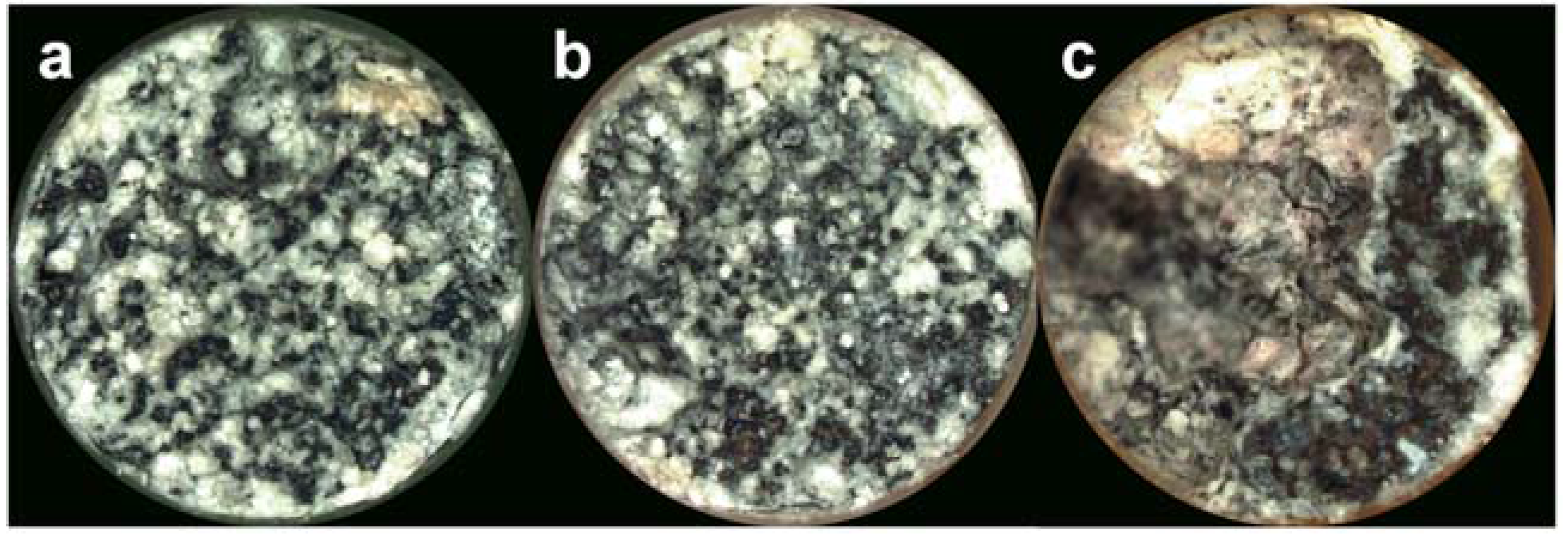
| MCZ | MCZS | MS | |||||||
|---|---|---|---|---|---|---|---|---|---|
| Mg | Zn | Ca | Mg | Zn | Ca | Sr | Mg | Sr | |
| Region A | 97.93 | 1.78 | 0.30 | 97.89 | 1.82 | 0.29 | - | 100.00 | - |
| Region B | 97.85 | 1.70 | 0.46 | 62.38 | 22.19 | 13.38 | 2.05 | 98.56 | 1.44 |
| Region C | 57.91 | 26.34 | 15.75 | 66.01 | 22.23 | 8.52 | 2.24 | 82.49 | 17.51 |
| Region D | 98.02 | 1.61 | 0.37 | 88.18 | 7.26 | 4.20 | 0.36 | 80.47 | 19.53 |
| Region E | 80.74 | 7.65 | 11.62 | 89.76 | 2.38 | 7.85 | 0.01 | - | - |
| Time | MCZ | MCZS | MS |
|---|---|---|---|
| Initial (20 min) | −1.58 ± 0.03 | −1.59 ± 0.02 | −1.65 ± 0.03 |
| 24 h | −1.52 ± 0.00 | −1.52 ± 0.00 | −1.53 ± 0.03 |
| 6 Days | −1.50 ± 0.00 | −1.50 ± 0.00 | −1.51 ± 0.00 |
| MCZ (a) | MCZS (b) | MS (c) | p-Value (a vs. b) | p-Value (a vs. c) | p-Value (b vs. c) | |
|---|---|---|---|---|---|---|
| Ecorr (V vs. Ag/AgCl) | −1.36 ± 0.02 | −1.38 ± 0.02 | −1.50 ± 0.01 | 0.430 | 0.002 | 0.002 |
| Icorr (A/cm2) | 8.16 × 10−6 ± 2.48 × 10−7 | 1.33 × 10−5 ± 5.57 × 10−6 | 4.39 × 10−4 ± 1.04 × 10−4 | 0.299 | 0.007 | 0.008 |
| MCZ (a) | MCZS (b) | MS (c) | p-Value (a vs. b) | p-Value (a vs. c) | p-Value (b vs. c) | |
|---|---|---|---|---|---|---|
| RS (Ω·cm2) | 2.91 ± 2.21 | 3.48 ± 2.49 | 5.20 ± 3.09 | 0.923 | 0.411 | 0.613 |
| R1 (Ω·cm2) | 301.68 ± 23.55 | 253.50 ± 73.94 | 157.04 ± 19.77 | 0.416 | 0.000 | 0.088 |
| R2 (Ω·cm2) | 473.92 ± 39.06 | 383.46 ± 13.93 | 296.80 ± 64.75 | 0.010 | 0.004 | 0.082 |
| R3 (Ω·cm2) | 1860.00 ± 209.76 | 1676.00 ± 463.44 | 2218.00 ± 439.74 | 0.713 | 0.303 | 0.201 |
| L (H·cm2) | 1.41 × 104 ± 5.62 × 103 | 1.37 × 104 ± 4.25 × 103 | 2.05 × 104 ± 5.39 × 103 | 0.993 | 0.218 | 0.134 |
| Q1 (S·sa/cm2) | 8.17 × 10−5 ± 2.85 × 10−5 | 7.06 × 10−5 ± 3.07 × 10−5 | 5.32 × 10−5 ± 2.07 × 10−5 | 0.828 | 0.233 | 0.571 |
| α1 | 0.46 ± 0.02 | 0.47 ± 0.03 | 0.47 ± 0.03 | 0.768 | 0.848 | 0.995 |
| Q2 (S·sa/cm2) | 1.36 × 10−4 ± 2.81 × 10−5 | 1.94 × 10−4 ± 3.68 × 10−5 | 7.14 × 10−5 ± 5.83 × 10−6 | 0.061 | 0.013 | 0.003 |
| α2 | 0.82 ± 0.05 | 0.85 ± 0.05 | 0.79 ± 0.01 | 0.713 | 0.363 | 0.116 |
| RP (Ω·cm2) | 546.62 ± 28.18 | 459.99 ± 80.84 | 376.26 ± 64.04 | 0.153 | 0.005 | 0.228 |
| Method | MCZ | MCZS | MS |
|---|---|---|---|
| Tafel Analysis | 0.187 | 0.303 | 10.024 |
| EIS | 0.001 | 0.001 | 0.011 |
| ICP-MS | 0.011 | 0.013 | 0.041 |
© 2017 by the authors. Licensee MDPI, Basel, Switzerland. This article is an open access article distributed under the terms and conditions of the Creative Commons Attribution (CC BY) license (http://creativecommons.org/licenses/by/4.0/).
Share and Cite
Brooks, E.K.; Ehrensberger, M.T. Bio-Corrosion of Magnesium Alloys for Orthopaedic Applications. J. Funct. Biomater. 2017, 8, 38. https://doi.org/10.3390/jfb8030038
Brooks EK, Ehrensberger MT. Bio-Corrosion of Magnesium Alloys for Orthopaedic Applications. Journal of Functional Biomaterials. 2017; 8(3):38. https://doi.org/10.3390/jfb8030038
Chicago/Turabian StyleBrooks, Emily K., and Mark T. Ehrensberger. 2017. "Bio-Corrosion of Magnesium Alloys for Orthopaedic Applications" Journal of Functional Biomaterials 8, no. 3: 38. https://doi.org/10.3390/jfb8030038





